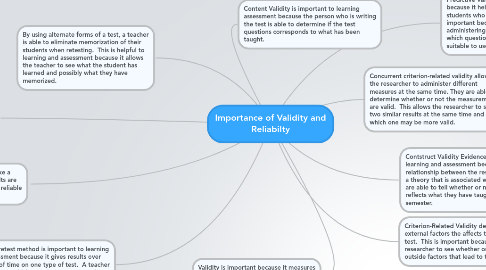Importance of Validity and Reliabilty
by Seana Andrzejewski

1. Split Half Method is important because it splits the tests in half making it shorter and memorization on the student's parts is eliminated. This is a part of internal consistancy.
2. By using alternate forms of a test, a teacher is able to eliminate memorization of their students when retesting. This is helpful to learning and assessment because it allows the teacher to see what the student has learned and possibly what they have memorized.
3. The test-retest method is important to learning and assessment because it gives results over a period of time on one type of test. A teacher is able to see which questions are appropriate and which ones are not.
4. Content Validity is important to learning assessment because the person who is writing the test is able to determine if the test questions corresponds to what has been taught.
5. Validity is important because it measures the evidence that we say it measures (Kubiszyn & Borich, 2010).
6. Reliability: The same individuals take a test more than once and if the results are the same or close it is considered a reliable test.
7. Contstruct Validity Evidence is important to learning and assessment because it shows the relationship between the results of the test and a theory that is associated with it. Teachers are able to tell whether or not their tests reflects what they have taught throughout the semester.
8. Predictive Validity Evidence is important because it helps predict future behaviors of the students who are taking the tests. This is important because the teachers who are administering the exam are able to predict which questions on the tests may be more suitable to use.
9. Concurrent criterion-related validity allows the researcher to administer different measures at the same time. They are able to determine whether or not the measurements are valid. This allows the researcher to see two similar results at the same time and see which one may be more valid.
10. Criterion-Related Validity determines if there is external factors the affects the results of the test. This is important because it allows the researcher to see whether or not there are outside factors that lead to their results.


